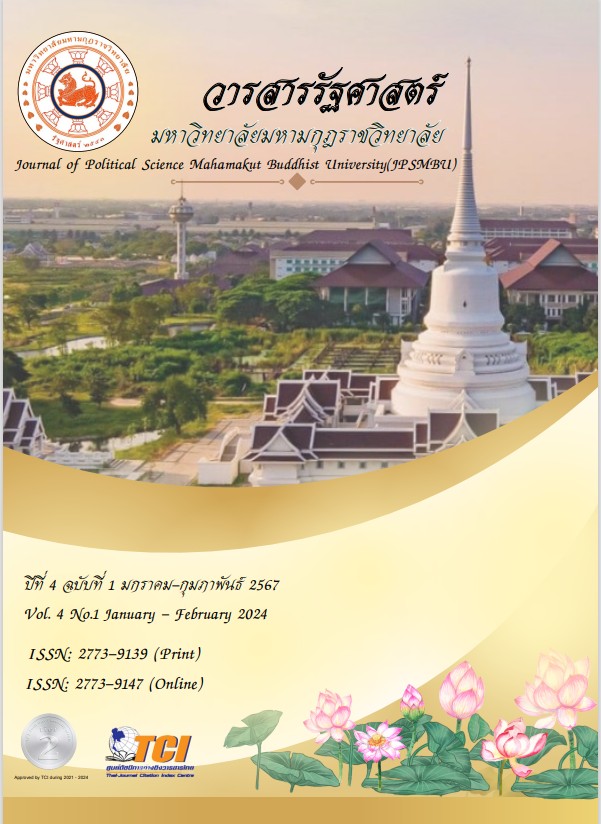STRATEGIC CHALLENGES FOR LOWER MEKONG NATIONS IN CHINA'S LANCANG-MEKONG WATER MANAGEMENT
Main Article Content
Abstract
The Mekong River is a major waterway that flows through six countries, namely China, Myanmar, Laos, Thailand, Cambodia, and Vietnam. For the Mekong Nations, this river likens the current of life, is exceptionally rich in natural resources, and is vital in supporting the livelihood of more than 70 million people. There are many cooperation frameworks, such as the Greater Mekong Sub-Region Economic Cooperation Development Program, established to support trade and investment in this sub-region. China's dam building on upstream of the Mekong River has led to reduced water flows downstream, causing severe impacts on fishing communities, the agriculture and transportation sectors. Moreover, it also effects disrupted the migration patterns of fish and other aquatic species. This article studies Conflict Management and Alternative Dispute Resolution (ADR) to suggest a solution to the Mekong Nations conflict, which has the Mekong River Commission and Yunnan officials as key factors. The solutions, phase by phase, are as follows: Phase 1: Building trust and cooperation between all parties involved in the conflict including Yunnan officials and other stakeholders. Phase 2: Balancing economic development and environmental protection to ensure that economic development and hydropower development would not affect the environment or downstream communities. Phase 3: Conflict resolution and management by encouraging the adoption of more transparent and participatory decision-making processes and involving downstream communities in water management.
Article Details

This work is licensed under a Creative Commons Attribution-NonCommercial-NoDerivatives 4.0 International License.
References
Belt and Road Portal. (2022). China to establish 33 new cross-border e-commerce pilot zones. Retrieve from http://www.asean-cn.org/index.php?m=content&c=index&a=show&catid=202&id=2916)
Caceres, S. B., & Ear, S. (2013). The Hungry Dragon: How China's Resource Quest is Reshaping the World. Routledge.
Chung, J. H., & Lam, T. C. (Eds.). (2009). China's local administration: traditions and changes in the sub-national hierarchy. Routledge.
Cooperation between China and Central and Eastern European Countries. (2013). The China-ASEAN Expo. Retrieve from http://www.china-ceec.org/eng/fwpt_1/zhxx/201610/t20161028_6831981.htm
Forsyth, L. (2017). China’s Domestic Dams: Hydropower not only an export for world’s biggest dam builder. Retrieve from https://news.mongabay.com/2017/02/chinas-domestic-dams-hydropower-not-only-an-export-for-worlds-biggest-dam-builder/.
Friedman, E. (2018). China's Salween dam claims in doubt after Myanmar bans hydro projects. Reuters. Retrieved from https://www.reuters.com/article/us-myanmar-hydropower-idUSKCN1GK0QZ
Hudson-Rodd, N., & Shaw, B. J. (2003). Mekong river development: Whose dreams? Which visions?. Water International, 28(2), 268-275.
International Energy Agency. (2019). Coal 2019: Analysis and forecasts to 2024. Retrieve from https://www.iea.org/reports/coal-2019
International Energy Agency. (2021). Oil 2021: Analysis and forecast to 2026. Retrieve from https://www.iea.org/reports/oil-2021
Li, M. (2014). Local Liberalism: China's provincial approaches to relations with Southeast Asia. Journal of Contemporary China, 23(86), 275-293.
Magee, D. (2011). The dragon upstream: China’s role in Lancang-Mekong development. In Politics and development in a transboundary watershed: The case of the lower Mekong Basin (pp. 171-193). Dordrecht: Springer Netherlands.
Mekong River Commission. (2022). Mekong low flow and drought conditions in 2019–2021: Hydrological conditions in the Lower Mekong River Basin. Vientiane: MRC Secretariat.
Ministry of Commerce, PRC (2015). China and Laos Signs the Joint General Scheme of Mohan-Boten Economic Cooperation Zone. Retrieve from http://english.mofcom.gov.cn/article/newsrelease/significantnews/201509/20150901109922.shtml
Priscoli, J. D., & Wolf, A. T. (2009). Managing and transforming water conflicts. Cambridge University Press.
Sticklor, R. (2010). Managing the Mekong: Conflict or Compromise? Retrieve from https://www.newsecuritybeat.org/2010/12/managing-the-mekong-conflict-or-compromise/
Thailand Arbitration Center. (n.d.). What is Alternative Dispute Resolution. Retrieve from https://thac.or.th/th/what-is-adr-th/
U.S. Energy Information Administration. (2023). China imported record volumes of crude oil in the first half of 2023. Retrieve from https://www.eia.gov/todayinenergy/detail.php?id=60401
Wang, Q. (2019). Giant Dragon in the Small River: China’s Regionalism in the Mekong Region (Doctoral dissertation, University of Macau).
Xinhua. (2021). China's Yunnan Province Eyes Closer Ties with Southeast Asia. Retrieve from http://www.xinhuanet.com/english/2021-05/11/c_139942391.htm.
Yeophantong, P. (2014). China’s Lancang dam cascade and transnational activism in the Mekong region: Who’s got the power?. Asian Survey, 54(4), 700-724.
Yeophantong, P. (2014). China’s Lancang dam cascade and transnational activism in the Mekong region: Who’s got the power?. Asian Survey, 54(4), 700-724.
Zeng, B., He, C., Mao, C., & Wu, Y. (2023). Forecasting China's hydropower generation capacity using a novel grey combination optimization model. Energy, 262, 125341.
Zhong, Y., Tian, F., Hu, H., Grey, D., & Gilmont, M. (2016). Rivers and reciprocity: perceptions and policy on international watercourses. Water Policy, 18(4), 803-825.


